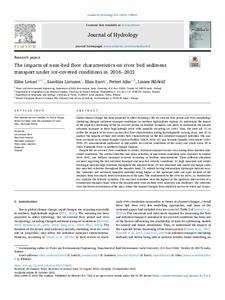The impacts of near-bed flow characteristics on river bed sediment transport under ice-covered conditions in 2016–2021
Lotsari Eliisa; Lintunen Karoliina; Kasvi Elina; Alho Petteri; Blåfield Linnea
https://urn.fi/URN:NBN:fi-fe2022112967662
Tiivistelmä
Global climate change has been projected to affect hydrology, the ice-covered flow period and river morphology (including changed sediment transport conditions) in northern high-latitude regions. To understand the impact of the expected shortening of the ice-covered period on bedload transport, one needs to understand the present sediment transport in these high-latitude rivers with annually occurring ice cover. Thus, the aims are (1) to define the impacts of ice cover on near-bed flow characteristics during hydrologically varying years, and (2) to analyse the impacts of these mid-winter flow characteristics on the bed sediment transport potential. The analyses are based on Acoustic Doppler Current Profiler (ADCP: 2016–21) and Acoustic Doppler Velocimeter (ADV: 2020–21) measurements performed in mid-winter ice-covered conditions of the sandy and small (circa 20 m wide) Pulmanki River in northern Finnish Lapland.
Despite the ice-covered river conditions in winter, sediment transport occurs even during these harshest mid-winter conditions. The critical velocities and shear velocities of mid-winter conditions were exceeded in winters 2016–2021, and bedload transport occurred according to bedload measurements. Three different situations occurred regarding the bed sediment transport and near-bed velocity conditions: (1) high measured mid-winter discharges indicate high velocities throughout the meander bend; (2) low measured mid-winter discharges cause low near-bed velocities throughout the meander bend; (3) winters having intermediate discharges indicate near-bed velocities and sediment transport potential being higher at the upstream inlet and apex sections of the meander bend but clearly lower downstream of the apex. The confinement by the river ice cover, i.e. bottom-fast ice, explains the velocity variation. The near-bed velocities were the highest at the upstream inlet section of a symmetrical meander bend, where the measurement cross-sections were narrower and shallower. The velocities were the lowest downstream of the apex, where the channel changed from relatively narrow to wider and deeper.
Kokoelmat
- Rinnakkaistallenteet [27094]
